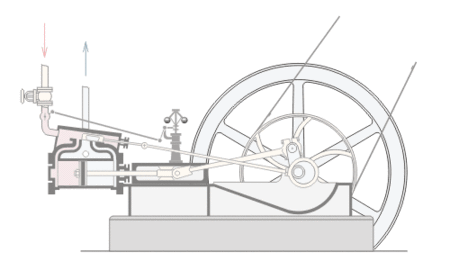
ANT
WOMAN - Is
this the world's largest insect? Anthony the giant 'Bulldog' ant is seen
here at the entrance to the Museum, with a young volunteer (Miss Ocean)
helper - who actually worked on the cart that Anthony sits on. 'Miss
Ocean' is a conservationist, keen on the country and rewilding, who also
hates ocean
plastic. But loves the humpback whales &
dolphins
that are forced to swim in our marine litter.
In
the fight against climate change, wood is good. Fossil
fuels are bad. There are too many
housing estates built of brick. Wood is a carbon lock, as timber grows
it captures carbon dioxide, and converts it to a useful building
material.
Being
a timber building, the Museum at Herstmonceux represents a fine example
of wood as a long-lasting and practical use of the material for
constructional purposes in an industrial environment. It is thought the
building was made from two Colonial flatpacks of the type exported to
the colonies around C. 1890. They are approximately 110 - 124 years old.
Proving that even untreated, timber can outlast brick builds, that need
re-pointing and other remedials. An brick buildings cannot withstand
earth movements as well as the more flexible wooden equivalent. One
example of which was in Jamaica
on June the 7th 1692, when a significant earthquake,
triggered a tsunami
that engulfed Port
Royal. In that event, the brick builds were totally destroyed,
whereas the timber quarters provided to workers, survived. An abject
lesson for British Empire builders, who before that event believed
timber builds to be inferior. When in fact, in some circumstances they
offer many advantages.

BLENDING
IN - This roof started out as a legal requirement under Health
& Safety Regulations. Since there is a requirement to protect
visitors to the museum and workers, from falling
branches and trees. That unfortunately, the Scots Pine species is
prone to. The Scots pine (Pinus sylvestris) is an evergreen conifer native to northern Europe. Mature trees grow to 35m and can live for up to 700 years. The bark is a scaly orange-brown, which develops plates and fissures with age. Twigs are green-brown and hairless.
Apart from falling branches, in high winds branches blown from adjacent
trees can be very dangerous. At present, the Museum has no beneficial
use to help pay for the upkeep of this important heritage asset. What is
at present protection for those working underneath, could well evolve
into an attraction
that generates an income for the Museum.
Herstmonceux
Museum hosts an Innovation Hub, almost all of which exhibits
concern solar and electric vehicles. This is our contribution towards
Net Zero, in showing visitors how it is possible to think outside the
box, with the aim of inspiring climate engineers and entrepreneurs of
the future. Maybe even to inspire councillors and politicians yet to be
elected, that climate innovation should be nurtured and encouraged, with
demonstrable results in the form of three full size vehicles on display
with cartridge exchange (instant) refueling for BEVs and HFCEVs. This,
despite the innovator not receiving any kind of support from local
authorities. Imagine then the possibilities if future innovators are
supported. There is even a model of a hydrogen
truck refuelling station, derived from the cartridge based system,
named SmartNet™.
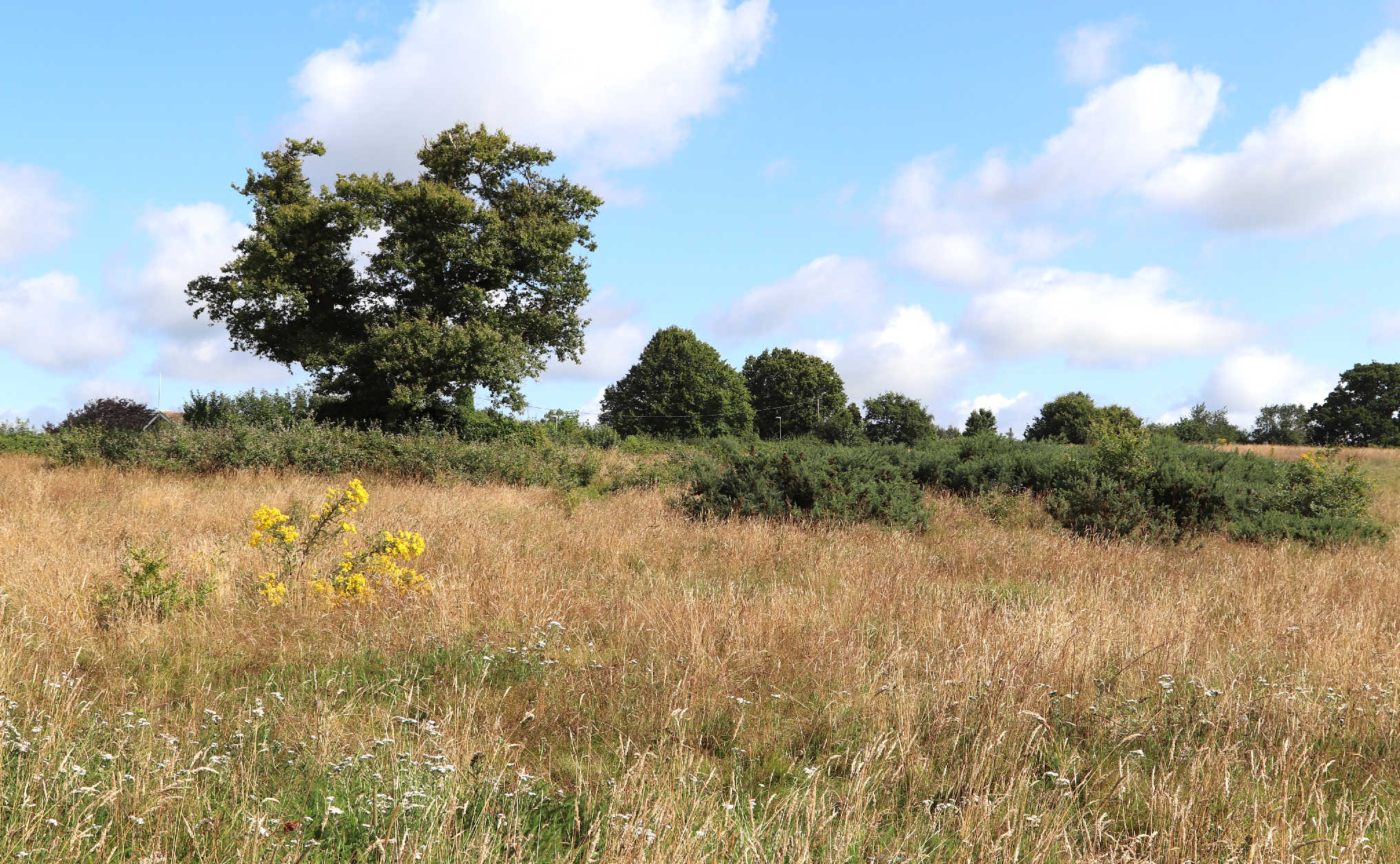
Now
that is what we call rewilding. The oak tree in the middle of this
field, and others dotted around the perimeter have been seeding rather
well. The tall grass and other shrubs are providing homes for much
wildlife. The hope is that, apart from footpaths and historic rights of
way, that this becomes a focal point for family walks, ramblers, hikers
and dog walkers in the village of Herstmonceux.
SOLAR
PANELS
As
with the use of timber, energy bills can be reduced, hence carbon
footprints, in installing solar
panels, that are now economical and
significantly reduce the cost of operating the Museum complex. Also
cutting emissions from greenhouse
gases, when totally reliant on fossil
fuels for electricity generation.
REWILDING
Rewilding can mitigate global
climate change by restoring ecosystems. An example of this would be rewilding pasture land, thereby reducing the number of cows and sheep and increasing the number of trees.
The long-term shifts in weather pattern and temperature reflect a range of changes from threatening biodiversity to ecosystem functioning. Large herbivores and carnivores contribute to key processes to influence climate change mediation and adaptation across terrestrial ecosystems. Rewilding enhances ecosystem functioning and services by long term maintenance of carbon stocks. The most beneficial effects on biogeochemical cycling and ecosystem structure are reported through rewilding large herbivore species.
Trophic rewilding can enhance the carbon capture and storage of ecosystems and has been posited as a "natural climate solution". The functional roles animals perform in an ecosystem, such as grazing, nutrient cycling and seed distribution, can influence the amount of carbon soils and plants capture in both marine and terrestrial environments. The carbon cycle is altered through herbivores consuming vegetation and assimilating carbon within their own biomass, releasing additional carbon by respiration and defecation after digestion. A study in a tropical forest in Guyana found that an increase in mammal species from 5 to 35 increased tree and soil carbon storage by four to five times, compared to an increase of 3.5 to four times with an increase of tree species from 10 to 70.
PLANTING TREES
Planting trees is the most efficient and scalable nature-based solution to fighting climate change and helping to achieve the Paris Agreement targets of restricting global warming to 1.5°C. Forests have great potential to help absorb more of the excess carbon dioxide (CO2) in the atmosphere as trees absorb it and store as carbon, making forests the largest land based carbon sink. Preserving and restoring forests is internationally recognised as being essential to helping fight
climate
change, but there is a surprising way that trees could help store more carbon, by cutting them down.
Although all plant matter absorbs carbon dioxide from the atmosphere, trees sequester (absorb and store) some of the carbon in their trunk, potentially storing it for hundreds of years. Uniquely the wood itself continues to act as a carbon store after the tree is felled and the timber is used in construction or the manufacture of furniture. Using timber in construction also reduces the carbon footprint of buildings compared to other building materials, meaning that wood offers great potential to revolutionise the greenhouse gas emissions of the construction industry.
Please
note that as the access to the Museum is along country paths near trees,
please be wary of falling
branches.
HOW IS CARBON STORED IN TIMBER
Trees absorb carbon dioxide from the atmosphere and use photosynthesis to convert it into glucose, which is then circulated to the cells where it is needed and transformed into energy via respiration. Any unused glucose is stored as starch in the living cells of the trunk and roots. Over time the living layer of the tree trunk is turned into non-living heartwood, of which carbon is a key component. The carbon remains locked in the heartwood until it decays or is burned.
This means that if trees are felled and cut into timber or pulped, the carbon stays in the wood or paper that is produced, again until it decays or is burned. Wood has been used as a construction material for thousands of years, but modern processing techniques are broadening the horizons of where and how wood can be used to construct buildings.
SUSTAINABLE BUILDING
There is pressure on the construction industry to find alternative building materials because cement and concrete production account for 8% of global greenhouse gas emissions and the global iron and steel industry account for another 5%. It is estimated that half a tonne of CO2 is emitted to manufacture 1 tonne of concrete, and 2 tonnes of CO2 are emitted in the manufacture of 1 tonne of
steel. Wood is increasingly being considered as a viable alternative in both residential and larger building projects as it is the ultimate renewable material with multiple benefits for reducing carbon.
Firstly, the use of timber reduces the embodied carbon in a building, i.e. the
carbon footprint of the building’s creation, because there are lower emissions associated with its production.
Timber also acts as a carbon sink because it preserves the carbon that is stored in the wood, preventing its release back into the atmosphere as carbon dioxide. Sustainable forestry practices can ensure that felled trees are replaced and that new growing trees will continue to absorb
carbon
dioxide, increasing the carbon sequestration potential. If buildings are designed so that the disassembly and recycling of materials is incorporated into the initial plan, then the timber can be further reused. Any timber has these benefits that combine to make it a renewable source of material, but engineered
wood products extend the capabilities and carbon sequestration potential of timber even further.
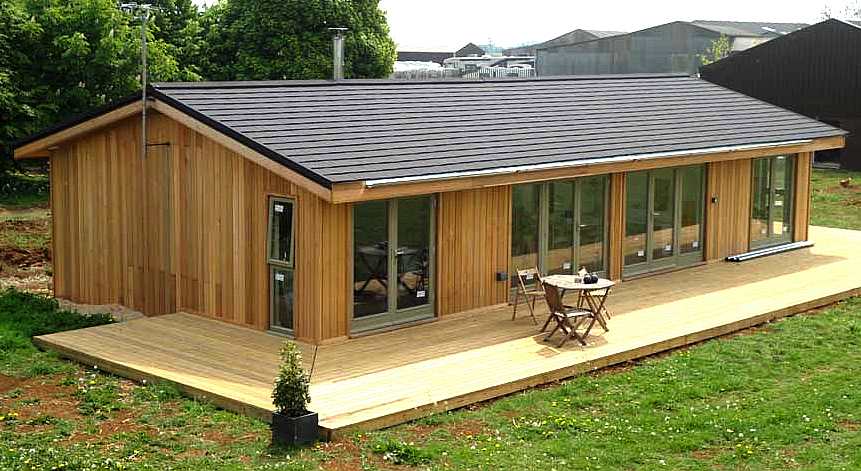
Timber
is versatile, recyclable and beautiful. A construction material working
with nature.
Timber has been used to build houses for thousands of years, but more recently the development of engineered structural timber or ‘mass timber’ has allowed wood to be used in major construction projects to create ‘plyscrapers’. Mass timber involves attaching pieces of either softwood (e.g. pine, spruce or fir) or hardwood (e.g. birch, ash or beech) together to form panels or structural elements such as beams. This results in timber that is strong, fire-resistant, lightweight, versatile and aesthetically pleasing. There are two primary forms of mass timber that have different applications.
Cross-laminated timber (CLT) is the most popular form of mass timber and the one that holds the most promise for architects. It is formed by gluing dried lumber boards cut from a single log in layers (typically 3, 5 or 7), with the grain in each layer lying perpendicular to the previous layer.
The depth of the wood panel can be adjusted (up to 30cm thick) by changing the number of layers and multiple panels can be joined together to cover larger expanses. The structure of CLT provides its strength and it can match or exceed the performance of concrete and steel, making it suitable for floors, walls, ceilings or even entire buildings.
Glue-laminated timber (glulam) is similar to CLT but the lumber boards are arranged with the grain running in the same direction. It is commonly used for beams and columns and can be readily formed into curved shapes. Glulam allows for larger and longer expanses than CLT and has been used for centuries; the earliest known example that is still standing is the 1866 assembly room of King Edward VI college in Southampton.
THE ADVANTAGES OF MASS TIMBER
One of the advantages of mass timber is that it can use weaker or younger growth trees with smaller diameters (as small as 11.5cm) than traditional timber requires. This has benefits for forest biodiversity because stands of older trees can be left intact and younger regenerative growth or logs from thinning can be used to provide effective timber products. Using wood in construction projects turns urban spaces into a carbon sink and avoids the high emissions of alternative building materials. Each cubic metre of cross-laminated timber is estimated to contain 1 tonne of sequestered CO2, representing a significant carbon store in every building in which it is used, although this will vary dependent on forestry practices. This equates to a potential 26.5% reduction in global warming potential of a CLT hybrid building compared to a concrete building.
Contrary to what might be expected, mass timber performs well in fire and indeed in some construction projects steel frames are given a mass timber cladding to protect them in the case of fire. Mass timber panels and beams are also lightweight compared to steel and concrete, allowing larger structures such as Dalston Works to be built with more shallow foundations on sites where there is infrastructure such as tunnels below. Wooden structures also have good resilience to earthquakes and can be repaired afterwards, unlike concrete which cracks and needs to be replaced.
Brock Commons, an 18 storey hybrid mass timber residence in the University of British Columbia.
Using mass timber in construction allows buildings to be completed more quickly as panels are manufactured to fit and shipped to site, resulting in lower labour costs. Mass timber buildings can reduce construction time by 25% to 30% and reduce onsite traffic by 90% and there is less waste because the panels can be precision designed and prefabricated to fit specific spaces. The buildings that result are undeniably aesthetically appealing and there can be health and wellbeing benefits associated with wooden buildings as they lower heart rate and blood pressure and improve air quality inside. Finally, the increased use of timber creates rural jobs in forestry and incentivises the creation of sustainable
forests.

SCOTLAND
- Loch Ard
THE GLOBAL POTENTIAL OF TIMBER AS A CARBON STORE
It is only recently that the carbon sequestered in harvested wood products has been included as part of national
greenhouse gas inventories, with IPCC guidelines being published in 2006. Calculating how much carbon is currently stored in timber is a complex process, partly due to balancing the carbon losses and gains caused by international timber movements. Extrapolating the global carbon sink potential for timber used in construction is even more complicated as there are multiple facets: estimating the future demand for new buildings, assessing whether there is scope to increase forest cover to meet that demand, accounting for the emissions reductions from using timber, and accounting for the carbon sequestered in the timber. There is also a significant question about how to factor in the fate of the timber products when the building is replaced, although wood can be recycled to avoid the carbon being returned to the atmosphere.
It is estimated by one study that there is currently around 0.09 billion tonnes of CO2 stored annually in harvested wood products across the world. This represents less than 1% of the current carbon budget of 36.6 billion tonnes of CO2 produced by human activity. In the UK the figure for carbon sequestered within timber frame houses and engineered wood in new builds is estimated to be 1 million tonnes of CO2 annually, again less than 1% of the current 354 million tonnes of CO2 emissions produced in the UK.
The projections of how extensive this storage capacity could be depends on the percentage of timber used in construction. One recent study calculates this based on timber being used in 10%, 50% and 90% of new builds over the next 30 years, with global annual carbon storage figures of up to 0.08, 0.37 and 0.67 billion tonnes of CO2 respectively. In the 90% timber scenario this pushes the figure as a percentage of global carbon emissions to 2% at current figures, although this proportion would increase if global emissions drop. Another study estimated that the increase would be up to 0.44 billion tonnes of CO2 sequestered annually if the proportion of timber used remained the same. In addition, there would be a significant reduction in global emissions, potentially of 14 to 31%, as the use of concrete, cement and steel would be reduced.
The most striking explanation of how extensive this carbon store could be is best expressed by the fact that a building constructed from mass timber stores more carbon per square metre than the equivalent area of living forest, leading one article to conclude that we should chop trees down to sequester carbon and replant with younger trees that absorb carbon faster. The demand for new buildings is expected to soar, with the current stock doubling in the next 40 years, so it is essential that more sustainable building materials are used.
One of the key questions is whether there is scope within existing or potential forest cover to produce enough timber to meet the potential demand, without endangering old growth forests. A recent study estimated that there is sufficient surplus in current global forestry operations to allow timber to replace up to 90% of construction materials if some of the timber used for fuel is reallocated. A subsequent study examined this at a more national level and concluded that there are significant deficits within individual countries, where forest cover would need to be increased. As an example, the UK currently imports 81% of its wood products, potentially from forests that are not sustainably managed, although there is capacity to increase our timber extraction sustainably within the UK. Due to the time it would take new trees planted now to grow to an appropriate size, any discrepancy between demand and supply would require logging existing forest, which could lead to further deforestation in sensitive areas. Replacing the trees as they are felled is a solution and highlights that it is critical that any increase in the use of timber in construction is linked to high sustainability in forest operations.
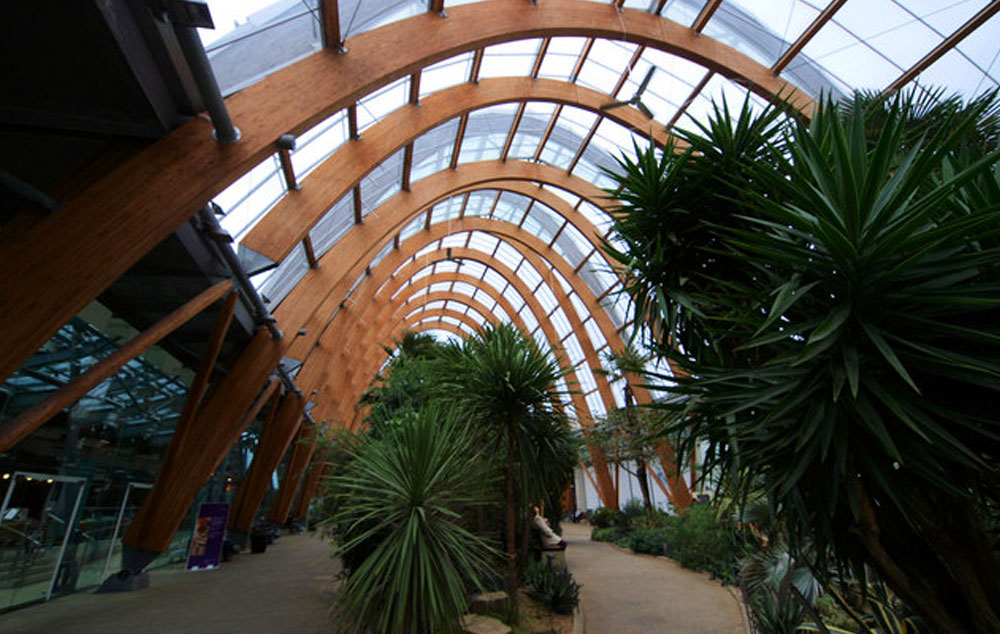
SHEFFIELD
- Winter Gardens
SUSTAINABLE FORESTRY
Deforestation for timber harvesting and land clearance is one of the key drivers of climate change and biodiversity loss, and it is globally acknowledged that there is an urgent need to stop deforestation of primary forest. Increasing timber demand appears to conflict with the need to restore forests high in biodiversity, but incorporating sustainable practices into forestry, such as those stipulated in the international Forest Stewardship Council (FSC) voluntary accreditation, can ensure that timber is a truly renewable product. FSC commitments include replacing trees that are felled, protecting sensitive forest areas from harvesting, preserving biodiversity, and ensuring that local workers are employed in forestry operations, with full traceability throughout the supply chain. FSC requirements are linked into national schemes such as the UK Woodland Assurance Standard and the UK Forestry Standard, which stipulates that every new forestry project must include at least 5% planting of native broadleaves to increase native biodiversity. The UK has a good record of sustainable forestry and 80% of the wood harvested in the UK is grown to FSC standards, although as previously mentioned this is homegrown wood is only a small fraction of the timber that we use.
The need to increase biodiversity in habitats globally has led to criticism of non-native forest plantations as they do not tend to increase habitat for native species. In the UK, however, the non-native plantations of species such as Sitka Spruce have adapted to our climate and biodiversity can be high across many taxonomic groups. Effective forest management can improve biodiversity even in ancient woodlands and forests high in biodiversity also have higher carbon sequestration. Forestry operations such as thinning and creating clearings restore biodiversity and generate logs that can be used for mass timber. It is essential that we manage our existing forests effectively and increase forest cover to improve biodiversity, but rather than forestry being an additional pressure on maintaining forest cover, sustainable timber extraction can form part of the restoration process.
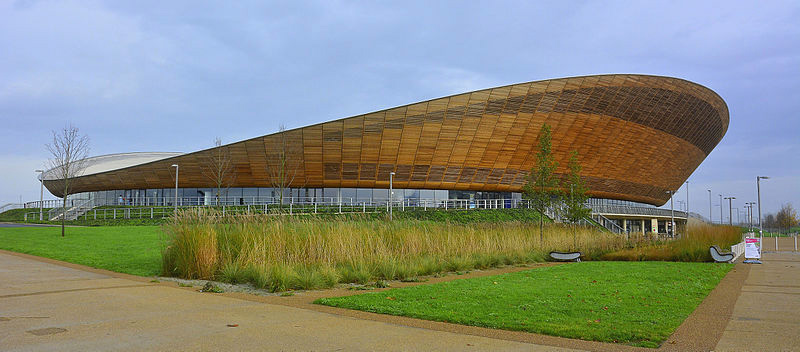
LONDON
- Olympic Velodrome
THE
KING'S SPEECH 17 JULY 2024
My Lords and Members of the House of
Commons, My Government will govern in service to the country.
My Government’s legislative programme will be mission led and based upon the principles of security, fairness and opportunity for all.
Stability will be the cornerstone of my Government’s economic policy and every decision will be consistent with its fiscal rules. It will legislate to ensure that all significant tax and spending changes are subject to an independent assessment by the Office for Budget Responsibility [Budget Responsibility Bill]. Bills will be brought forward to strengthen audit and corporate governance, alongside pension investment [Draft Audit Reform and Corporate Governance Bill, Pension Schemes Bill].
Securing economic growth will be a fundamental mission. My Government will seek a new partnership with both business and working people and help the country move on from the recent cost of living challenges by prioritising wealth creation for all communities. My Ministers will establish an Industrial Strategy Council. It is my Government’s objective to see rising living standards in all nations and regions in the United Kingdom.
My Ministers will get Britain building, including through planning reform, as they seek to accelerate the delivery of high quality infrastructure and housing [Planning and Infrastructure Bill]. They will also pursue sustainable growth by encouraging investment in industry, skills and new technologies.
My Government is committed to making work pay and will legislate to introduce a new deal for working people to ban exploitative practices and enhance employment rights [Employment Rights Bill]. It will seek to establish the appropriate legislation to place requirements on those working to develop the most powerful artificial intelligence models.
My Government believes that greater devolution of decision making is at the heart of a modern dynamic economy and is a key driver of economic growth and my Ministers will introduce an English Devolution Bill [English Devolution Bill]. Legislation will be introduced to give new powers to metro mayors and combined authorities. This will support local growth plans that bring economic benefit to communities.
A Bill will be introduced to allow local leaders to take control of their local bus services [Better Buses Bill]. My Ministers will bring forward legislation to improve the railways by reforming rail franchising, establishing Great
British Railways and bringing train 8 operators into public ownership [Passenger Railway Services (Public Ownership) Bill, Rail Reform Bill].
Taken together these policies will enhance Britain’s position as a leading industrial nation and enable the country to take advantage of new opportunities that can promote growth and wealth creation.
My Government recognises the urgency of the global climate challenge and the new job opportunities that can come from leading the development of the technologies of the future. It is committed to a clean energy transition which will lower energy bills for consumers over time. A Bill will be introduced to set up Great British Energy, a publicly owned clean power company headquartered in Scotland, which will help accelerate investment in
renewable energy such as offshore
wind [Great British Energy Bill]. Legislation will be brought forward to help the country achieve energy independence and unlock investment in energy infrastructure. A Bill will be introduced to support
sustainable aviation fuel production [Sustainable
Aviation Fuel (Revenue Support Mechanism) Bill]. My Government recognises the need to improve water quality and a Bill will be introduced to strengthen the powers of the water regulator
[Water (Special Measures) Bill].
My Government will seek to strengthen the border and make streets safer. A Bill will be introduced to modernise the asylum and immigration system, establishing a new Border Security Command and delivering enhanced counter terror powers to tackle organised immigration crime [Border Security, Asylum and Immigration Bill]. Legislation will be brought forward to strengthen community policing, give the police greater powers to deal with anti social behaviour and strengthen support for victims [Crime and Policing Bill, Victims, Courts and Public Protection Bill].
Measures will be introduced to improve the safety and security of public venues and help keep the British public safe from terrorism [Terrorism (Protection of Premises) Bill]. My Government will bring forward plans to halve violence against women and girls.
My Ministers will seek to raise educational standards and break down barriers to opportunity. Action will be taken to get people back in employment following the impact of the pandemic. A Bill will be introduced to raise standards in education and promote children’s wellbeing [Children’s Wellbeing Bill]. Measures will be brought forward to remove the exemption from Value Added Tax for private school fees, which will enable the funding of six and a half thousand new teachers. My Government will establish Skills England which will have a new partnership with employers at its heart [Skills England Bill], and my Ministers will reform the apprenticeship levy.
Legislation will be introduced to give greater rights and protections to people renting their homes, including ending no fault evictions and reforming grounds for possession
[Renters’ Rights Bill]. Draft legislation will be published on leasehold and commonhold reform [Draft Leasehold and Commonhold Reform Bill].
A Bill will be introduced to establish an independent football regulator to ensure greater sustainability in the game and strengthen protections for fans [Football Governance Bill].
My Government will improve the National Health Service as a service for all, providing care on the basis of need regardless of the ability to pay. It will seek to reduce the waiting times, focus on prevention and improve mental health provision for young people. It will ensure mental health is given the same attention and focus as physical health. My ministers will legislate to modernise the Mental Health Act so it is fit for the twenty first century [Mental Health Bill]. A Bill will be introduced to progressively increase the age at which people can buy cigarettes and impose limits on the sale and marketing of vapes [Tobacco and Vapes Bill]. My Ministers will also legislate to restrict advertising of junk food to children along with the sale of high caffeine energy drinks to children. A draft Bill will be brought forward to ban conversion practices [Draft Conversion Practices Bill].
My Government will take steps to help rebuild trust and foster respect. Legislation will be brought forward to introduce a duty of candour for public servants [Hillsborough Law]. A Bill will be introduced to establish a statutory Armed Forces Commissioner to act as a strong independent champion for our gallant Armed Forces and their families [Armed Forces Commissioner Bill].
Legislation on race equality will be published in draft to enshrine the full right to equal pay in law [Draft Equality (Race and Disability) Bill].
My Government will strengthen its work with the devolved governments in Scotland,
Wales and Northern Ireland so that the best outcomes possible are delivered for citizens across the United Kingdom. My Ministers will establish a new Council of the Nations and Regions to renew opportunities for the Prime Minister, heads of devolved governments and mayors of combined authorities to collaborate with each other.
My Government will continue to support the political institutions and devolved government in Northern
Ireland. In consultation with all parties, measures will be brought forward to begin the process of repealing and replacing the Northern Ireland Troubles (Legacy and Reconciliation) Act 2023 [Northern Ireland Legacy Legislation].
Measures to modernise the constitution will be introduced including House of Lords reform to remove the right of hereditary peers to sit and vote in the Lords
[House of Lords (Hereditary Peers) Bill]. My ministers will strengthen the integrity of elections and encourage wide participation in the democratic process.
The Government will propose a modernisation committee of the House of Commons which will be tasked with driving up standards, improving work practices and reforming procedures.
My Government will ensure a strong defence based on the North Atlantic Treaty Organisation’s common values of individual liberty, democracy,
human rights and the rule of law. Its commitment to NATO will remain unshakeable. It will maintain a strong Armed Forces, including the nuclear deterrent. To ensure that the United Kingdom’s defence capabilities are matched to the changing nature of global strategic threats, my Government will conduct a Strategic Defence Review.
My Government will continue to give its full support to Ukraine and its people and it will endeavour to play a leading role in providing
Ukraine with a clear path to
NATO membership.
My Government will seek to reset the relationship with European partners and work to improve the United Kingdom’s trade and investment relationship with the European Union. My Ministers will seek a new security pact to strengthen cooperation on the mutual threats faced by the
United Kingdom and the European Union.
My Government will play its part in trying to secure long term peace and security in the Middle East. It is committed to a two state solution with a safe and secure Israel alongside a viable and sovereign Palestinian state.
Later this week, my Government will host the European Political Community meeting at Blenheim Palace. The Queen and I look forward to our Visit to
Samoa alongside the Commonwealth Heads of Government Meeting in October, and our Visit to
Australia.
Members of the House of Commons
Estimates for the public services will be laid before you.
My Lords and Members of the House of Commons
Other measures will be laid before you.
I pray that the blessing of Almighty God may rest upon your counsels.

KING
CHARLES - PRO REWILDING & RENEWABLES
In
The King’s Speech
on the 17th July 2024, important first steps were taken to deliver the new UK Government’s agenda for nature and climate. Advanced renewable energy provision and tackling the cavalier, profit-maximalist approach by
water companies that has resulted in four in five of our waterways not being in good ecological condition are front and centre of the plans. And yet, with no nature-focused bill, there is an almost complete lack of priority given to the vital role of nature’s restoration at scale in our nation’s future.
In the UK we now have a huge opportunity to integrate our responses to the climate and nature emergencies and for the Labour government, in cooperation with the devolved administrations, to lead the way on this.
MAKING
THE LINK BETWEEN GLOBAL WARMING AND POLICIES
Halting nature’s decline and ensuring its recovery is one of the biggest challenges for the new Defra team and beyond. There are many solutions at hand, such as: prioritising nature’s recovery across all our protected landscapes (nearly 25% of land in England) and seascapes; reintroducing vital missing species to the wild; doubling our woodland cover; expanding nature-based jobs and businesses; and banning bottom trawling across all our Marine Protected Areas (MPAs).
To make a meaningful rapid difference, we must be bold. Incentivising the large-scale restoration of natural processes (meandering rivers, natural grazing, habitat succession, connected seascapes etc) across 30% of Britain’s land and seas, would put us back on track to reversing the current declines. Nature is also an amazing natural climate solution, so we need Labour to link nature and climate action by supporting rewilding as a vital and cost-effective means of delivering on our
net zero commitments.
The Labour government’s emphasis on a green energy transition and creating good jobs in the industrial heartlands is exciting and progressive.
To deliver a truly
green economy we need to also consider the importance of a green land and marine use transition.
Agriculture alone currently produces 10% of the UK’s
greenhouse
gases. We know that rewilding 30% of Britain could help reverse that. It could sequester up to 53 million tonnes of CO2/year – equivalent to 12% of our current emissions – and make a significant contribution to achieving net zero.
By working with nature rather than against it, we might save the planet.
We
hope that these guiding principles as to tackling climate change, coupled
with our technological exhibits might inspire generations of young
scientists, and conservationists to think outside the box, as the innovators appear to have come up with
some quite remarkable solutions, all in one geographical location. As some kind of
spontaneous think tank, inventive Mecca, or creative commune, where ideas
come to life. There is no reason you cannot do the same. Provided
the State nurtures such talent. The first step of which is recognising
the innovators in their midst, then assisting, rather than hindering
such creativity. Mostly, creative people are seen as a threat, because
they do not conform. Yet, conformity stifles creativity.
